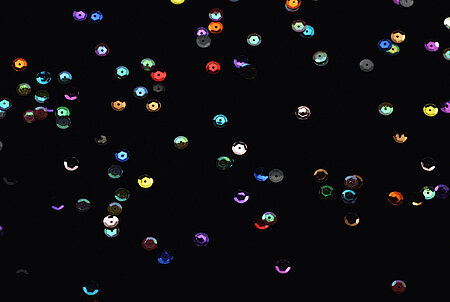DASCHNER stages the acts of showing and concealing. In the title alone, which makes a trademark of the filmmaker and artist’s name, the transfer is evoked as the suspensed state of a desirable intermediate space. The exhibition, which links three cooperation partners in Neue Galerie Graz, Diagonale and Kunsthaus Graz, moves between medial, filmic and gender-based spaces, thematising media realities and characteristics, as well as stereotypes presented both before and behind the camera lens. Various configurations of showing, creating and performing present exhibition, theatre and cinema space as a closely related, sensual event.
Appearance: White Cube. Silver dance floor. Professional lamp tripods, intensely-coloured pictures made of flowing paint, tapes, and textile bases are the protagonists of the small, separated art room in front of the bright green curtain. Behind it, a studio-like Black Box is concealed, in which large-format, jet-black pictures with silvery, sparkling embroidery define the side-walls.
At the end of the room, two films on a continuously alternating loop demonstrate mysterious affinities between the body and the backdrop: with its steady camera, its precisely choreographed close-ups, Pferdebusen (2017) – awarded the Diagonale Film Prize for Innovative Cinema the previous year – reveals the interplay and transfer between architectural details, bodily fragments and surface definitions as the sensual stage and focus of Katrina Daschner’s work. The film is part of an eight-part series that has been worked on since 2012, a re-writing based on Arthur Schnitzler’s Dream Story, which is permeated by suppressed erotic fantasies, restricting gender roles, and a disturbing desire for secrets. Daschner’s Pferdebusen, with its detailed views of animal and human body parts, its feeling of leather surfaces, masks and smoke, or with its horses’ clip-clopping, is able to tempt – and unsettle – on both the auditory and visual level. The film emphasises the theatrical element of the situation, introducing us to a glamorous world of leather saddles, naked behinds, the seams along theatre seats – capturing that all on film with a camera that moves forward tentatively.
With the second film Hiding in the Lights (2013), filmed in the Palau de les Arts Reina Sofia in Valencia, stage presence is studied at the moment of apparent relaxing and leaving the role, when Denice Bourbon and Daschner herself indulge in the applause from the invisible audience, complete with gloriously vulgar stage smiles, lascivious movements, and playfully coy gestures. ‘Daschner’s preferred trope is a visual synecdoche, where one surface stands for another. Clothing and accessories imitate body surfaces. The tension between them exposes literally that which is concealed in the spotlight (“in the lights”) and can quickly be disregarded.’ (Ewa Szabłowska) The film, like the whole exhibition, is a precisely timed format of the narrated and the exhibited, sensual heterotopia. In the sense of a space of changed hierarchies, non-linearities, stereotypes or gender allocations, the audience plunges into a dreamy novella, in which space and time are wonderfully timed in filmic terms, yet cannot be categorised overall. A dream-like and associative suspended state of free, ecstatic corporeality. The stage in Daschner is not only the location and medium of the negotiation, but also the place of truth, which can only be ambiguous.
Once before she already built an exhibition with two rooms, in the Kunstpavillon in Innsbruck, where the venue became the negotiating space of staging, representation and ascription. Her embroidered pictures are choreographic architectural sketches, whose outlines drawn with the thread recall the coolness of modernism. At the same time, the glittering storyboards are handicraft of strange homeliness, in the marvellous ambiguity of which the inadequacy of clarity is echoed. DASCHNER answers the question as to the necessity of classification and ascription in art, too, with a fertile concealment, when props turn into sculptural objects, and surfaces into vague secrets with sensual properties. DASCHNER ‘tells us that – and how – apparently clearly divided spaces, spheres, strata, are connected with one another, and also want to be: once again, and at last, it does not matter to which categories things are usually ascribed: artificial or real, two- or three-dimensional, fantasy or reality – here they become one, the collage makes it so, animated by a vision of life in which things are permitted to flow into one another. Longing has an end, the celebration of existence begins in its all-encompassing splendour.’ (Olaf Möller)
The departure is certain: physically pervasive, mysteriously intoxicated.
The official festival trailer, which can be seen at the Diagonale and in cinemas in the run-up period, is shown parallel to this at different places in the Kunsthaus Graz, which is also the Festival Centre of Diagonale’18.
The sixth part of the eight-part series, titled Pfauenloch, based on the dream novella, will be shown at the festival on March 15th at 1.30 pm in the Schubertkino.



































